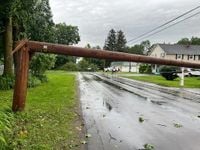Heavy storms swept across Central New York on Sunday, June 22, 2025, unleashing a potent mix of torrential rain, fierce winds, and hail that left tens of thousands without power and prompted emergency declarations in multiple counties. The deluge was particularly severe in Chenango and Oneida counties, where flash flooding and widespread damage disrupted communities and overwhelmed local resources.
In Chenango County, the National Weather Service (NWS) issued a rare Flash Flood Emergency shortly before 9 a.m., warning residents of a "particularly dangerous situation" as between 3 and 5 inches of rain had already fallen. Floodwaters surged through creeks and roadways, inundating homes and stranding at least 10 people. Towns such as Norwich, Sherburne, and New Berlin reported significant flooding, with roads and bridges submerged under water. The severity of the event led Chenango County officials to declare a state of emergency, urging residents to seek higher ground immediately.
"This is a Flash Flood Emergency for Chenango County," the NWS stated. "This is a particularly dangerous situation. Seek higher ground now!" The warning remained in effect into Sunday afternoon as emergency crews worked to assess and respond to the rapidly evolving crisis.
Meanwhile, the storm system's wrath extended beyond Chenango County. Madison County experienced flash flooding as well, with images showing rushing floodwaters engulfing farmland near Morrisville. The New York Department of Transportation mobilized crews to clear debris from roads, a necessary effort given the earlier reports of nearly two dozen damaging wind incidents farther north in the state. These winds had uprooted trees and downed power lines, compounding the challenges faced by emergency responders.
Oneida County bore the brunt of the storm's fury in terms of power outages and wind damage. By Sunday morning, nearly 60,000 customers across Central New York were without electricity, with Oneida County alone accounting for approximately 37,500 outages. The town of Kirkland declared a state of emergency, urging residents to stay indoors for their safety. The Clark Mills Fire Department opened the Clark Mills Senior Center as a shelter for those displaced or seeking refuge from the storm’s aftermath.
Wind gusts reached up to 62 mph in Westmoreland, Oneida County, according to the New York State Mesonet system. Hailstones as large as 1.5 inches further battered the region, damaging property and complicating cleanup efforts. Rainfall totals in Oneida and Madison counties ranged from 2.5 to 3.5 inches, contributing to localized flooding and road closures.
One of the most significant disruptions came on the New York State Thruway, where flooding forced the closure of the eastbound lanes between Exit 33 (Verona - Rome - Oneida) and Exit 32 (Westmoreland - Rome). Although by 10 a.m., only the left lane remained closed, the blockage underscored the storm’s impact on critical transportation infrastructure. Additionally, Route 365 was closed due to downed trees between Mappa Avenue and Mapledale Road in Barneveld, further hampering travel in the area.
Madison County issued a travel advisory effective until noon Sunday, cautioning motorists about lingering hazards from the storm damage. Other counties in the region, including Broome, Tioga, Susquehanna, and Wayne, were also under Flash Flood Warnings into the afternoon, highlighting the widespread nature of the severe weather event.
Power outages extended beyond Oneida County, affecting thousands in Madison (11,484), Oswego (6,465), and Onondaga (4,202) counties as well. Utility companies National Grid and New York State Electric and Gas reported ongoing efforts to restore service, but the scale of the disruption suggested it could take some time before all customers were back online.
The combination of heavy rainfall, strong winds, and hail created a multifaceted emergency scenario. Trees and power lines downed by the wind not only caused widespread outages but also posed hazards that slowed emergency response and cleanup operations. Flooded roadways forced closures and stranded residents, while emergency shelters opened to accommodate those displaced or seeking safety.
Local officials emphasized the importance of heeding warnings and staying off the roads unless absolutely necessary. The Clark Mills Fire Department, for example, specifically urged residents in Kirkland to remain home during the ongoing emergency. As the storm moved through, authorities continued monitoring conditions and coordinating response efforts to mitigate further harm.
These storms serve as a stark reminder of how quickly weather conditions can escalate into life-threatening situations. The rare Flash Flood Emergency in Chenango County and the extensive power outages across Central New York underscore the vulnerability of communities to extreme weather events, even in areas not typically prone to such severe flooding.
As cleanup continues and power restoration efforts progress, residents are urged to stay informed through official channels and to exercise caution around floodwaters and downed power lines. Emergency services remain on high alert, prepared to assist wherever needed in the wake of this powerful storm system.
While the immediate threat is subsiding, the impacts of the flooding and wind damage will be felt for days to come as Central New York recovers from one of its more intense early summer storms in recent memory.

